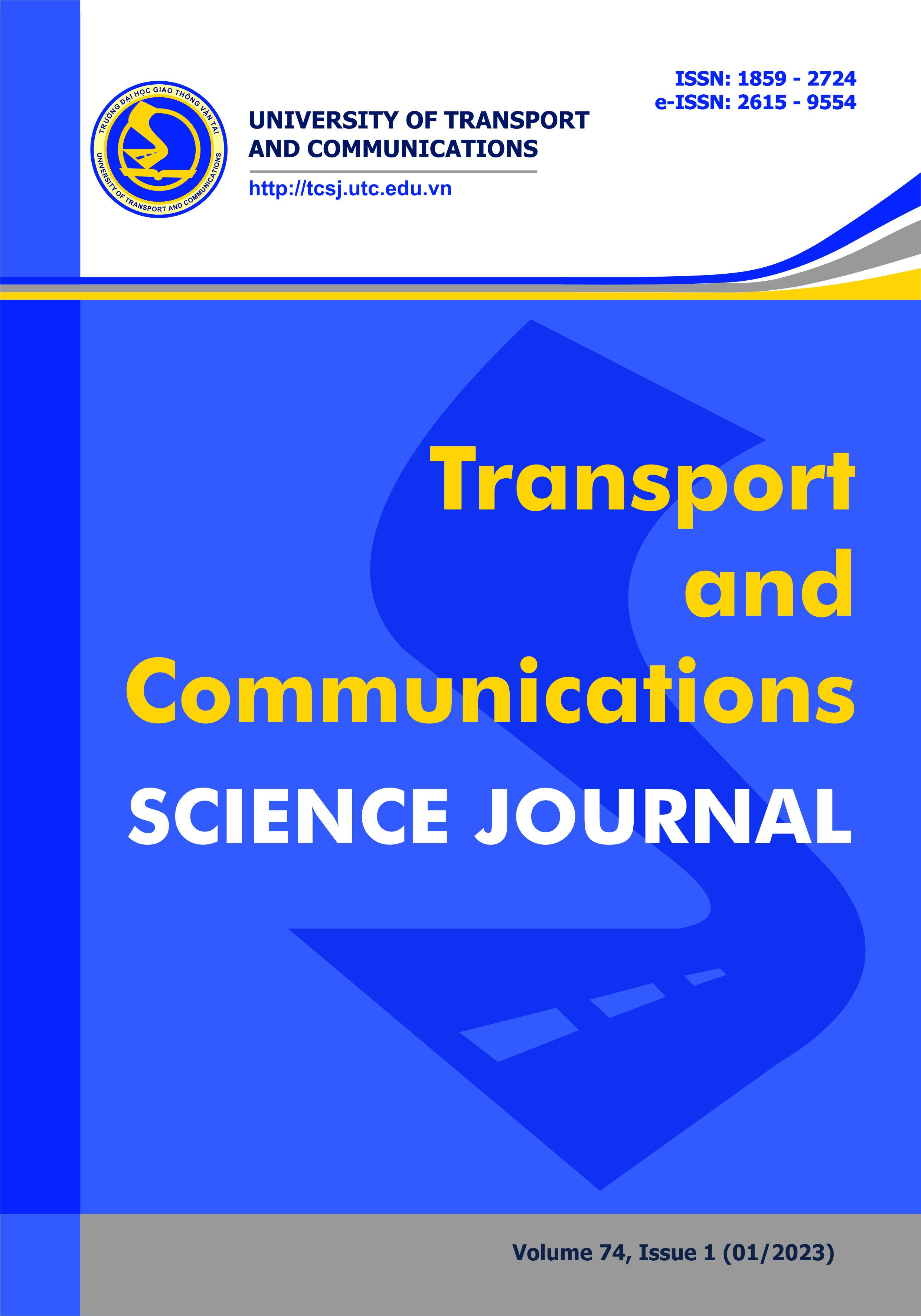Thermodynamic analysis of a waste heat recovery libr/H2O single effect absorption chiller system in textile in Vietnam
Email:
vankha.pham@utc.edu.vn
Từ khóa:
Energy analysis, exergy analysis, waste heat recovery, absorption chiller, overall heat conductance model
Tóm tắt
Model for energy and exergy analysis of absorption refrigeration using waste heat from textile factory has been built. The analysis that uses different models of heat exchangers are the overall heat conductance (UA) model, and the effectiveness model. The result show that the exergy loss in the generator and absorber are the larger than condenser and evaporator. Therefore, it is necessary to focus on improving these two important devices in absorption chiller. For the convenience of system operation, the research analyzed the effects of generator inlet temperature and solution pump mass flow rate on the energetic and exergetic performance of the absorption chiller. The study results indicated that the exergy efficiency of the absorption chiller decrease from 0.2776 to 0.2146 when increasing the solution pump mass flow rate from 1.5 kg/s to 2.5 kg/s and the generator inlet temperature from 80 oC to 98 oC. Meanwhile, energy efficiency will increase slightly initial from 0.769 to 0.779 and then decrease from 0.779 to 0.776 as the generator inlet temperature increases from 80 oC to 98 oC when solution mass flow rate is 1.5 kg/s. And energy efficiency decreases from 0.769 to 0.734 when the solution pump mass flow rate increase from 1.5 kg/s to 2.5 kg/sTài liệu tham khảo
[1]. F. PanahiZadeh, N. Bozorgan, The Energy and Exergy Analysis of Single Effect Absorption Chiller, Advanced Design and Manufacturing Technology Journal, 4 (2011) 19-26.
[2]. A. Khaliq, R. Kumar, I. Dincer, Exergy Analysis of an Industrial Waste Heat Recovery Based Cogeneration Cycle for Combined Production of Power and Refrigeration, Journal of Energy Resources Technology, 131 (2009) 1-9. https://doi.org/10.1115/1.3120381
[3]. I. Dincer, T. A. H. Ratlamwala, Integrated absorption refrigeration systems: comparative energy and exergy analyses, Springer, 2016.
[4]. R. Roy, B. Kundu, Energy and exergy analyses of LiBr/H2O absorption cooling system having recto-trapezoidal profile absorber plate, Journal of Mechanical Engineering Science, 235 (2021) 2851-2873. https://doi.org/10.1177/0954406220959693
[5]. J. Abdulateef, S. D. Ali, M. S. Mahdi, Thermodynamic analysis of solar absorption cooling system, Journal of Advanced Research in Fluid Mechanics and Thermal Sciences, 60 (2019) 233-246.
[6]. D. Noor, A. Arshad, Z. A. Abdul Majid, H. Ibrahim, F. Basrawi, A review on the recent development of solar absorption and vapour compression based hybrid air conditioning with low temperature storage, in MATEC Web of Conferences, 2016, pp. 1-9. http://dx.doi.org.10.1051/matecconf/20163802007
[7]. M. Tenkeng, P. A. N. Wouagfack, D. Lissouck, R. Tchinda, Exergy analysis of a solar absorption refrigeration system in Ngaoundere, Journal of Power and Energy Engineering, 5 (2017) 1-18. https://doi.org/10.4236/jpee.2017.510001
[8]. A. Şencan, K. A. Yakut, S. A. Kalogirou, Exergy analysis of lithium bromide/water absorption systems, Renewable Energy, 30 (2005) 645-657. https://doi.org/10.1016/j.renene.2004.07.006
[9]. L. S. Lima and C. E. Keutenedjian Mady, Energy and exergy analysis of an absorption and mechanical system for a dehumidification unit in a gelatin factory, Entropy, 23 (2021) 1-14. https://doi.org/10.3390/e23040415
[10]. M. R. Ozdemir, A. Sahin, Energy, Exergy and Economic Analysis of Absorption Chiller Systems: A Case Study for a Wood Pencil Factory, International Journal of Renewable Energy Research, 11 (2021) 1469-1477.
[11]. K. E. Herold, R. Radermacher, S. A. Klein, Absorption chillers and heat pumps, CRC press, 2016.
[2]. A. Khaliq, R. Kumar, I. Dincer, Exergy Analysis of an Industrial Waste Heat Recovery Based Cogeneration Cycle for Combined Production of Power and Refrigeration, Journal of Energy Resources Technology, 131 (2009) 1-9. https://doi.org/10.1115/1.3120381
[3]. I. Dincer, T. A. H. Ratlamwala, Integrated absorption refrigeration systems: comparative energy and exergy analyses, Springer, 2016.
[4]. R. Roy, B. Kundu, Energy and exergy analyses of LiBr/H2O absorption cooling system having recto-trapezoidal profile absorber plate, Journal of Mechanical Engineering Science, 235 (2021) 2851-2873. https://doi.org/10.1177/0954406220959693
[5]. J. Abdulateef, S. D. Ali, M. S. Mahdi, Thermodynamic analysis of solar absorption cooling system, Journal of Advanced Research in Fluid Mechanics and Thermal Sciences, 60 (2019) 233-246.
[6]. D. Noor, A. Arshad, Z. A. Abdul Majid, H. Ibrahim, F. Basrawi, A review on the recent development of solar absorption and vapour compression based hybrid air conditioning with low temperature storage, in MATEC Web of Conferences, 2016, pp. 1-9. http://dx.doi.org.10.1051/matecconf/20163802007
[7]. M. Tenkeng, P. A. N. Wouagfack, D. Lissouck, R. Tchinda, Exergy analysis of a solar absorption refrigeration system in Ngaoundere, Journal of Power and Energy Engineering, 5 (2017) 1-18. https://doi.org/10.4236/jpee.2017.510001
[8]. A. Şencan, K. A. Yakut, S. A. Kalogirou, Exergy analysis of lithium bromide/water absorption systems, Renewable Energy, 30 (2005) 645-657. https://doi.org/10.1016/j.renene.2004.07.006
[9]. L. S. Lima and C. E. Keutenedjian Mady, Energy and exergy analysis of an absorption and mechanical system for a dehumidification unit in a gelatin factory, Entropy, 23 (2021) 1-14. https://doi.org/10.3390/e23040415
[10]. M. R. Ozdemir, A. Sahin, Energy, Exergy and Economic Analysis of Absorption Chiller Systems: A Case Study for a Wood Pencil Factory, International Journal of Renewable Energy Research, 11 (2021) 1469-1477.
[11]. K. E. Herold, R. Radermacher, S. A. Klein, Absorption chillers and heat pumps, CRC press, 2016.
Tải xuống
Chưa có dữ liệu thống kê

Nhận bài
14/08/2022
Nhận bài sửa
27/09/2022
Chấp nhận đăng
17/11/2022
Xuất bản
15/01/2023
Chuyên mục
Công trình khoa học
Kiểu trích dẫn
Van Kha, P., & Thi Thu Ha, T. (1673715600). Thermodynamic analysis of a waste heat recovery libr/H2O single effect absorption chiller system in textile in Vietnam. Tạp Chí Khoa Học Giao Thông Vận Tải, 74(1), 72-80. https://doi.org/10.47869/tcsj.74.1.7
Số lần xem tóm tắt
254
Số lần xem bài báo
214









